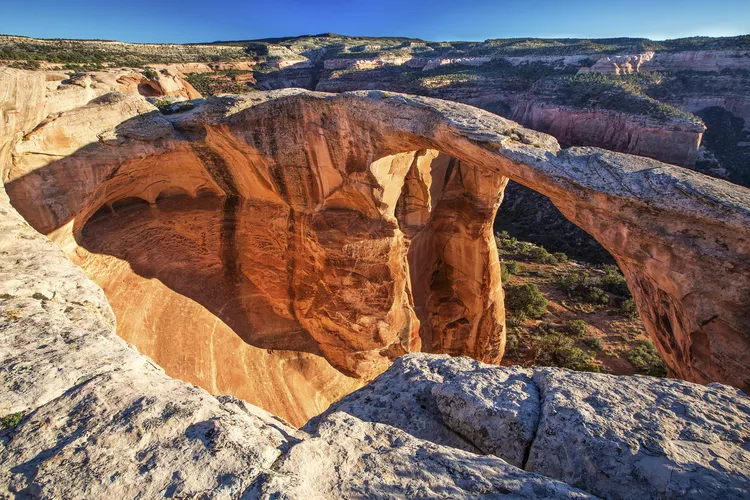Summary of McInnis Canyons National Conservation Area
- Overview: Discover breathtaking natural wonders including rock arches, hiking trails, and wildlife in this expansive conservation area.
- Location: Positioned near Grand Junction, this area offers diverse terrains and outdoor activities.
- Activities: Enjoy hiking, wildlife viewing, kayaking, and more in the picturesque landscapes.
It’s hard to find this many jaw-dropping natural wonders in one area. The McInnis Canyons National Conservation Area is home to a stretch of the Colorado River, great camping and hiking, geological and paleontological sites, and impressive stone arches.
In fact, McInnis boasts the highest concentration of natural rock arches in the state and the second most in the world, only second to Arches National Park. This alone makes it a bucket-list destination in Colorado.
The McInnis Valley National Conservation Area was designated in the year 2000, and today, it’s run by the Bureau of Land Management. It was named after Congressman Scott McInnis in 2005.
If you’re looking for an amazing outdoor destination in southern Colorado, rich with hiking, biking, horseback riding, wildlife viewing, camping, and hunting, here’s what you need to know to explore McInnis Canyons National Conservation Area.
The Details
This conservation area spans 122,300 acres. Cutting through the land is 24 miles of the Colorado River, as well as 75,500 acres of the Black Ridge Canyons Wilderness. Also in McInnis Canyons: the Rattlesnake Arches, sandstone canyons, and alcoves. You’ll see interesting plants, fossils, and ancient artifacts—plus, gorgeous views.
Elevation: 4,300 to 7,130 feet
Location: Near Grand Junction in Mesa County. The western boundary for this area is Utah.
Getting There: The terrain spans dry and high desert land to dramatic canyons. You can explore the land on foot, bike, motorcycle, ATV, or horseback ride. There are some roads specifically for cars, such as Rabbit Valley. However, getting deep into the wilderness requires foot or horseback access. Look for designated areas for various activities.
Multiple campgrounds and scattered campsites are available in the area. It is advisable to reserve a spot well in advance if you wish to stay the night.
Hiking
Hiking is popular here, and there are numerous trails to explore. Paleontology trails are a big draw to this area; how often can you incorporate a living history museum with your mountain hike? A great starting point is the Rabbit Valley Trail Through Time (aptly named). This short (1.4-mile) and easy (elevation gain: 180 feet) loop is technically an interpretive trail, complete with an information kiosk. Along this path, you can see the fossils of dinosaurs discovered at a working quarry. You’ll learn about all the dinosaurs that were found in the area. Due to the short length and educational aspect, this path is quite appealing for families.
For a less structured but equally impressive hike, the McDonald Creek Canyon hike brings you along a stream for 3.7 miles (there and back) until you reach the Colorado River. Here, keep your eyes open for rock art made by ancient people. Pro tip: Pack binoculars. They can be useful and will help you resist the temptation to step off the trail, which is not advised to protect the natural habitat. While it’s a bit long, the elevation gain is minimal, just 190 feet.
The aptly named Dinosaur Hill Trail is perfect for those who wish to combine dinosaur fossils with quick exercise and breathtaking views. This is where the Brontosaurus was recovered in 1901 and continues to be one of the most complete fossil discoveries of this species. This hike is rated for all levels, though the Bureau of Land Management describes it as “mildly strenuous,” with an elevation gain of less than 180 feet. Regardless, it’s short, about one mile long. At the top, you’ll be rewarded with a panorama that you’ll never forget.

Other Things to Do
Here are some highlights to consider in McInnis Canyons:
- The Old Spanish Trail: A piece of this historic trail runs through the area.
- The Kokopelli Trail: This 142-mile trail is popular among mountain bikers and goes all the way to Moab, Utah.
- Wildlife Viewing: Expect to see a variety of wildlife including elk, black bears, desert bighorn sheep, trophy mule deer, various birds, mountain lions, and bald and golden eagles.
- Kayaking: Experience the beauty of the Colorado River by canoeing or kayaking.
- Horseback Riding: A perfect trail for horseback riding is known as Wild Horse Mesa.
- Camping: The area has three campgrounds: Knowles Overlook, Jouflas, and Castle Rocks. Several individual campsites are scattered throughout the area. These sites are clearly marked and must be reserved. There are specific regulations regarding camping, such as requiring a portable toilet.





